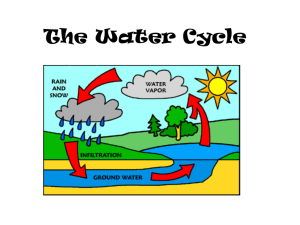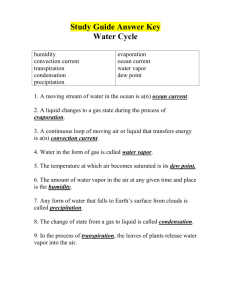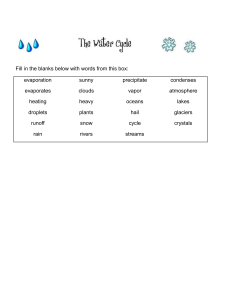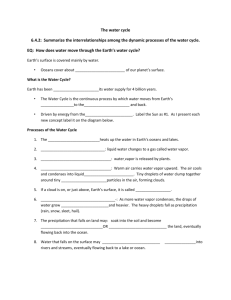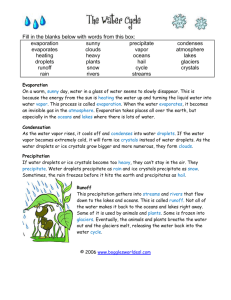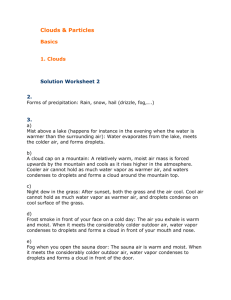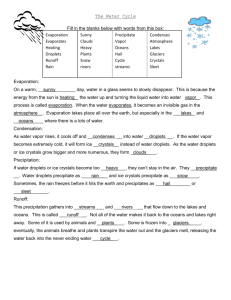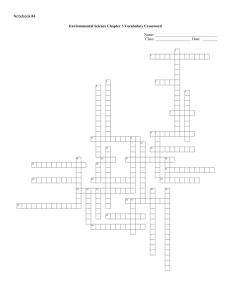grade 6 - Orange Public Schools
advertisement
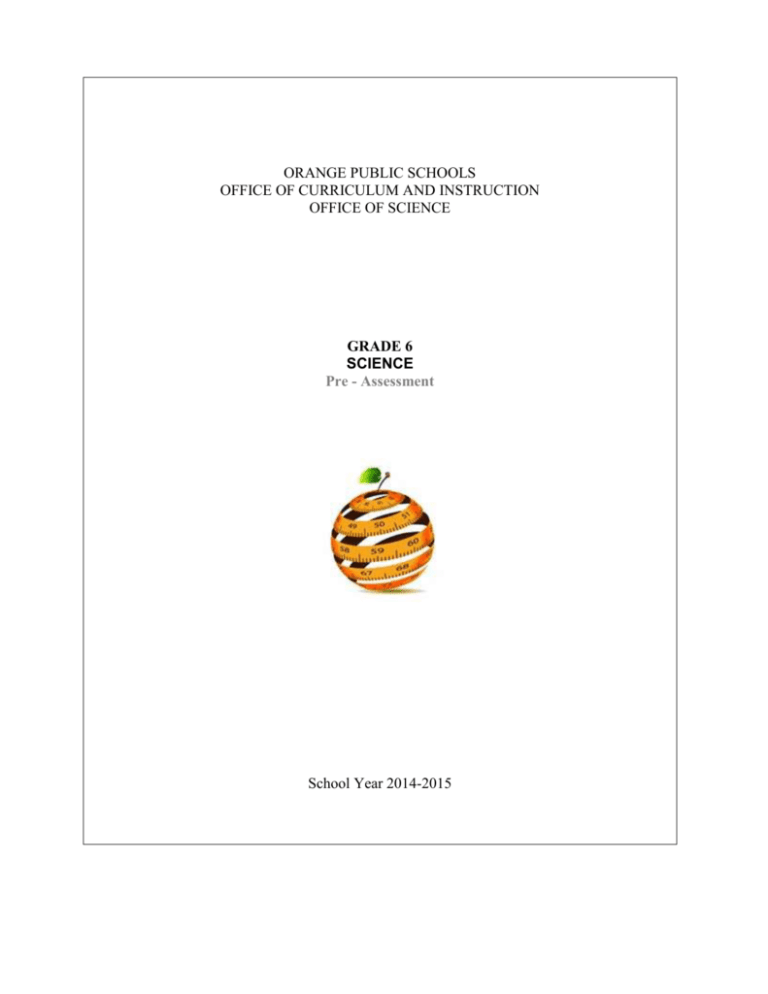
ORANGE PUBLIC SCHOOLS OFFICE OF CURRICULUM AND INSTRUCTION OFFICE OF SCIENCE GRADE 6 SCIENCE Pre - Assessment School Year 2014-2015 Directions for Grade 6 Pre-Assessment The Grade 6 Pre-Assessment is made up of multiple choice questions, constructed response questions and performance questions. Read each question carefully, including diagrams and/or graphs. Work as rapidly as you can without sacrificing accuracy. Do not spend too much time puzzling over a question that seems too difficult for you. Answer the easier questions first; then return to the harder ones. Try to answer every question, even if you have to guess. Where necessary, you may use scratch paper for your work. Do not use the margins of the test booklet to do scratch work. FOR ALL QUESTIONS, YOU MUST RECORD ALL OF YOUR ANSWERS ON THE TEST BOOKLET. Name _______________________________ Date_______________________ Unit 1 Pre-assessment Modified True/False Indicate whether the statement is true or false. If false, change the identified word or phrase to make the statement true. 1.Matter that has the ability to flow is called a fluid. _________________________ Multiple Choice 2. The most important source of Earth’s surface energy is: a. volcanic eruptions. b. geysers. c. the sun. d. the core. 3. A car that has rolled down a hill: a. has less potential energy. b. is more stable. c. has given up energy. d. All of the above 4. The atoms in solids can: a. vibrate in place. b. move freely about. c. vibrate and move freely about. d. vibrate and move freely about, but not at the same time. 5. Adding a teacup of hot water to a cold swimming pool: a. adds a small amount of heat to the pool. b. adds a large amount of heat to the pool. c. will only heat the part of the pool where the water was added. d. adds no heat to the pool. 6. In convection: a. heated gases rise. b. heated liquids rise. c. water or air currents form. d. All of the above 7. Energy from the Sun reaches the surface of Earth by: a. radiation. b. convection. c. conduction. d. All of the above Short Answer Explain w 8. Explain why the air above a parking lot on a sunny day rises. Use the terms buoyancy and density in your answer. ________ ______________________________________________________________________________________ ______________________________________________________________________________________ ______________________________________________________________________________________ ______________________________________________________________________________________ ______________________________________________________________________________________ ______________________________________________________________________________________ Circle the correct answer the following multiple choice questions. 9. What are the three states of water on Earth? A. groundwater, lakes, and clouds B. liquid water, frozen water, and water vapor C. gas, steam, and vapor D. groundwater, oceans, and ice 10. What word means the change of state from liquid to a gas? A. evaporation B. condensation C. eutrophication D. precipitation 11. How much of Earth’s water is fresh water? A. 97% B. 50% C. 3% D.1% 12. How is water stored in an aquifer? A. in an open underground lake B. in cracks and spaces in rocks C. in impermeable rock D. in wells and springs 13. Which of the following is needed to form a continental glacier? A. mountain B. ocean C. evaporation D. large land mass 14. When a geyser erupts, hot water comes to the surface. What causes the eruption? A. The pressure increases. B. The pressure decreases. C. The temperature decreases. D. A nearby volcano erupts. 15. What is transpiration? A. Transpiration is a process where water vapor enters the atmosphere when animals breathe. B. Transpiration is a process where water vapor forms clouds. C. Transpiration is a process where water vapor exits a plant through holes in the leaves. D. Transpiration is a process where water vapor enters the atmosphere as water evaporates from the ground. 16. How do droplets become heavy enough so that the droplets fall as rain or snow? A. The droplets gain mass from condensation within the clouds. B. When evaporation occurs, extra water vapors forms into more droplets. C. The droplets bump together and form larger droplets. D. The hotter air allows the droplets to solidify and fall from the clouds. Short Answer 17. Plants are an important part of the water cycle. Explain the process they are responsible for, and how they move water. ______________________________________________________________________________ ______________________________________________________________________________ ______________________________________________________________________________ ______________________________________________________________________________ ______________________________________________________________________________ ______________________________________________________________________________ ______________________________________________________________________________ 18. Why is it necessary for humans to protect and preserve our fresh water supplies? Where are the major supplies of fresh water found? ______________________________________________________________________________ ______________________________________________________________________________ ______________________________________________________________________________ ______________________________________________________________________________ ______________________________________________________________________________ ______________________________________________________________________________ ______________________________________________________________________________ 19.Tornados are known for: a. greater wind speeds than hurricanes. b. larger diameters than hurricanes. c. forming over oceans. d. traveling much faster than 60 km/hr. 20. A low pressure center causes: a. cold air to rush in. b. warm air to be forced upward. c. strong winds and air rotating around the center. d. All of the above 21. The Saffir-Simpson Hurricane rates hurricanes based on which of the following factors? a. Wind speed b. Damage c. Storm surge d. All of the above 22. An air mass is a large body of air with ____ temperature and pressure throughout. a. inconsistent b. varying c. decreasing d. consistent 23.A high pressure center is associated with: a. stormy weather. b. cold air rushing in. c. clear weather. d. rapidly rising warm air. 24. A thunderstorm is caused by: a. a convection cell called a thunder cell. b. warm air rising in an updraft and cooler air and rain falling in a downdraft. c. a cirrostratus cloud. d. lightning. 25. A major climate region with particular plants and animals is called a: a. biome. b. ecosystem. c. community. d. landform. 26. Why are the oceans important to Earth? a. They help maintain Earth’s heat balance and keep the temperatures from being extreme. b. Phytoplankton in the oceans provide most of the oxygen in Earth’s atmosphere. c. They provide an important source of water for the water cycle. d. All of the above 27. The low point of an ocean wave is called the: a. crest. b. trough. c. swell d. wavelength. Modified True/False Indicate whether the statement is true or false. If false, change the identified word or phrase to make the statement true. 28. Faunal Succession is the time it takes for half of a radioactive element to decay to a stable element. _________________________ 29. Relative dating uses various clues to figure out: a. the exact age of an object. b. the order of events over time. c. the color of an object. d. the behaviors of an organism. Short Answer 30. Explain how relative dating of fossils differs from absolute dating of fossils. ______________________________________________________________________________ ______________________________________________________________________________ ______________________________________________________________________________ ______________________________________________________________________________ ______________________________________________________________________________
